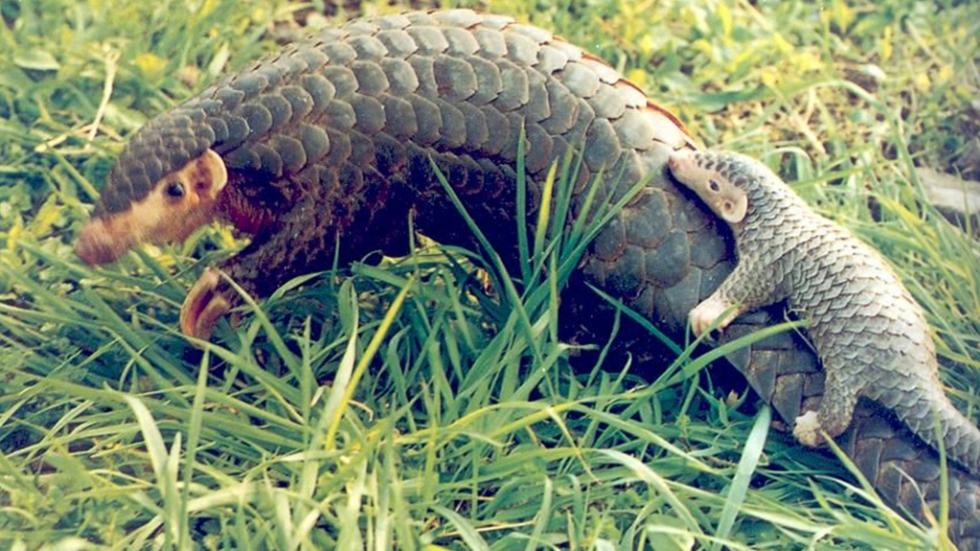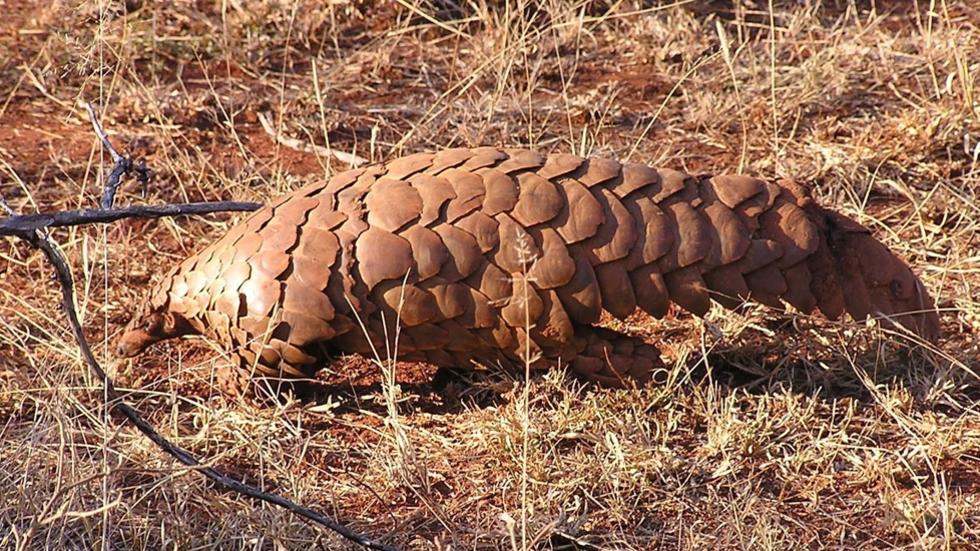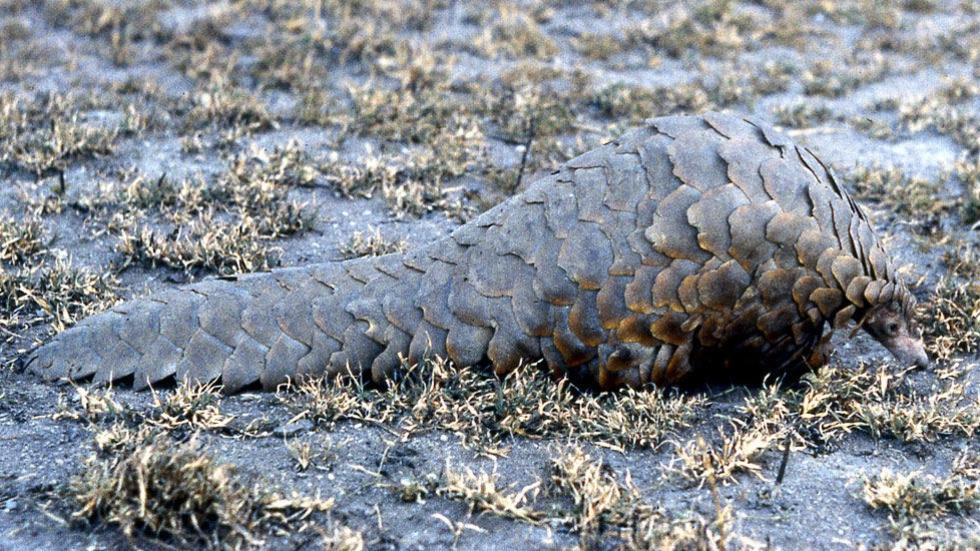Pangolins
Introduction
There are eight species of pangolin, all of which comprise the mammalian order Pholidota or “scaled animals,” referencing the keratinous scales that cover their bodies. The group has a long fossil history of more than 80 million years, but only one family remains today: Manidae. Four species live in Africa and four live in Asia. They are solitary, shy animals, and most species are nocturnal.
All pangolin species are myrmecophagous, meaning that they feed on ants and termites. They have many specialized adaptations for this lifestyle including sharp claws for breaking into termite mounds, tough skin to prevent ant bites, and extremely long tongues. Pangolins have poor hearing and eyesight, so they rely heavily on their sense of smell to find food. Once they find a termite mound or anthill, they use their long tongues to lap up hundreds of insects. Though the ants or termites try to fight back, the pangolin’s tough skin and ability to close its nostrils and ears while feeding leave them unable to defend their homes.
The Name
The genus name Manis come from the Latin word for “ghost” or “underworld,” which may refer to their solitary, nocturnal habits. The African species have different genus names: Smutsia and Phataginus. Smuts is from the German term for "dirt," which is logical as the two species in this genus are referred to as “ground pangolins.” Phata is Latin for “crack” and likely refers to the cracked look of their scales. As for their common name, pangolin comes from the Malay word for pangolins, pëngulin. This translates to “roller,” which describes their ability to roll into a tight ball. With their hard scales, this works as an excellent defense mechanism against predators. Their lifestyle gives them their other common name: “scaly anteater.”
 Temminck's Ground Pangolin, Manis temminckii. Credit: David Bygott. BY-NC-SA | While most pangolin names come from an aspect of their ecology, geography, or physiology, one pangolin is named after a naturalist. Temminck’s Pangolin (Smutsia temminckii) is named after Dutch zoologist, Coenraad Jacob Temminck. He was the first director of the National Museum of Natural History in Leiden and a member of the Royal Swedish Academy of Sciences. During his life (1778–1858), he wrote several books on ornithology, in addition to naming several species. Besides Temminck’s Pangolin, eight species of mammals, sixteen birds, eight fish, and two turtles have temminckii as part of their species name. |
Did you know? Pangolins were thought to be closely related to anteaters, aardvarks, sloths, and armadillos, as all of these animals have either no teeth or a much-reduced number. However, molecular data has shown that these animals are not closely related, and so pangolins were classified into their own group. It is now thought that their closest living relatives are the Carnivora, a group that includes cats, dogs, and bears.
The Tail of the Pangolin
 Phataginus tetradactyla,(synonym: Manis tetradactyla). Biodiversity Heritage Library, 1789. Public Domain | All species of pangolin have exceptionally strong tails. The tails of ground pangolins are important for stabilizing the animal as it uses its front claws to rip into ant and termite mounds. The tail also serves an important role in their locomotion. It is heavy enough to act as a counterweight for the cranial part of their body, so that they can walk bipedally. This gait allows them to keep their front claws sharp for digging as they are not worn down while they move around. Pangolins often carry their offspring, known as "pangopups," on top of their tails until the young can move around independently. Two pangolin species in Africa (Phataginus tricuspis and Phataginus tetradactyla), and two of the Asian species (Manis javanica and Manis culionensis) have prehensile tails. The prehensile tails increase maneuverability and stability for the pangolin while climbing. The Long-tailed Pangolin (Phataginus tetradactyla) has a tail that is almost double its body length. Its tail is so long that it holds the record for the mammal with the most vertebrae—46–47 caudal vertebrae alone. Did you know? A pangolin’s tongue can be up to 40 cm/15.75 inches long when fully extended, enabling it to burrow deep into anthills to lap up hundreds of ants. It is so long that it is anchored close to its pelvis. Its tongue is also coated in an extremely sticky saliva which guarantees that once a pangolin attacks, ants have no chance. It is estimated that a single pangolin can eat 70 million insects in a year! |
Earth’s Most-hunted Animal
Pangolins are the most trafficked animals in the world. It is estimated that more than one million pangolins have been taken from the wild from 2004–2014. Sales have been estimated to account for 20% of the entire wildlife black market. Traditional Asian medicinal practices use pangolin meat, scales, and fetuses as cures for many common ailments. Their meat can cost hundreds of dollars per pound.
Pangolins do not fare well in captivity, and therefore it is often hard to rehabilitate them even if they are rescued. Many pangolins suffer injuries and missing limbs from poachers, making their release back into the wild very difficult. Today, all four African pangolin species are considered vulnerable to extinction, and the four Asian species are endangered or critically endangered, according to the International Union for the Conservation of Nature (IUCN).
Learn More
Browse
Encyclopedia of Life Pangolin web page
Pangolin Images from the Biodiversity Heritage Library
Read
International Union for the Conservation of Nature (IUCN) Pangolin Specialist Group
Watch
A video by the non-profit WildAid on pangolins and threats to their survival.
Slideshow Image Credits:
Credit: Manis temminckii, Masteraah via Wikimedia Commons. Public Domain; Credit: Manis pentadactyla, EOL Regional China Center. CC BY-NC-SA; Credit: Manis temminckii, David Bygott via Flickr: EOL Images CC BY-NC-SA; Credit: Manis temminckii, Masteraah via Wikimedia Commons. Public Domain





